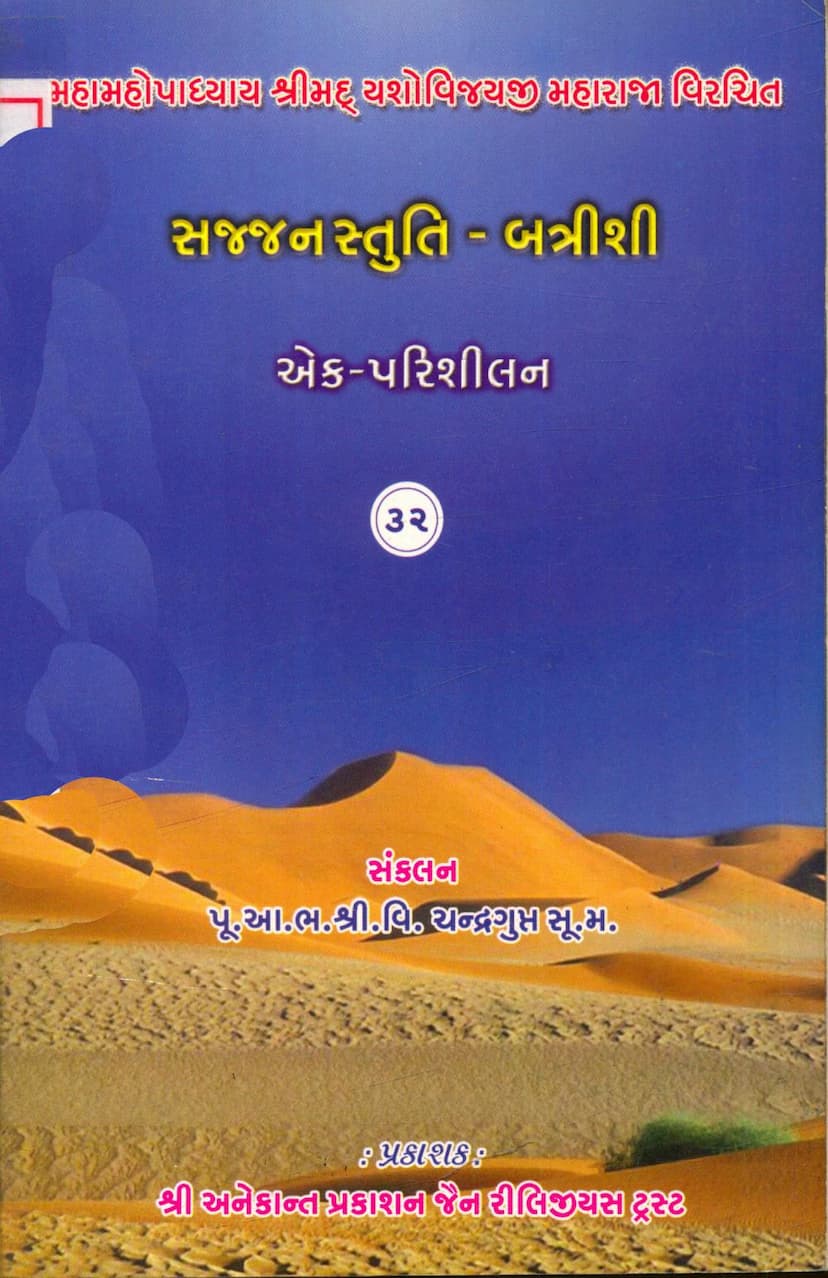Sajjan Stuti Battrishi Ek Parishilan
Added to library: September 2, 2025

Summary
Here's a comprehensive summary in English of the Jain text "Sajjan Stuti Battrishi Ek Parishilan" by Chandraguptasuri, based on the provided Gujarati text:
Book Title: Sajjan Stuti Battrishi Ek Parishilan (A Study of the Thirty-two Verses Praising the Virtuous) Author: Acharya Vijay Chandraguptasuri Publisher: Shri Anekant Prakashan, Khambhat Religious Trust
Overview:
This text, "Sajjan Stuti Battrishi Ek Parishilan," is a commentary and study of the "Sajjan Stuti Battrishi" (Thirty-two Verses Praising the Virtuous) by Mahamahopadhyay Shrimad Yashovijayji Maharaj. The original "Sajjan Stuti Battrishi" is part of his larger work, "Trish-Trishiksha Prakaran." This commentary provides an in-depth analysis and interpretation of the verses, which focus on distinguishing between virtuous individuals (Sajjan) and wicked individuals (Durjan) and highlighting the qualities and significance of the virtuous.
Key Themes and Content:
-
Purpose of the Commentary: The commentary aims to elucidate the meaning of the "Sajjan Stuti Battrishi," which itself was composed to explain the importance of virtuous individuals. The underlying principle is that understanding and venerating virtuous people helps maintain an attitude of non-aversion (advesh) towards them, which is crucial for spiritual progress and attaining liberation (moksha).
-
Distinguishing Virtuous from Wicked: A significant portion of the text is dedicated to contrasting the characteristics of "Sajjan" (virtuous, good, noble) and "Durjan" (wicked, bad, ignoble).
- Speech: Virtuous individuals speak sweet, nectar-like words, while wicked individuals habitually speak harsh words. Even when a wicked person speaks sweetly, it is driven by self-interest and hides inner harshness.
- Nature: Virtuous people appreciate the merits of scholars, while the wicked focus on finding faults.
- Impact: The verses use analogies like the sun and darkness, or the chakravaka bird and the owl, to illustrate that the presence of the virtuous illuminates and strengthens righteousness, while the wicked thrive in ignorance and negativity.
-
The Power of the Name "Sajjan": The name "Sajjan" itself is described as a potent mantra. When this name, akin to a family member, resonates in one's ears, the venomous words of the wicked lose their power, becoming ineffective due to this protective "mantra."
-
Virtuous People as Exemplars: The text draws parallels between virtuous individuals and divine beings or natural phenomena to highlight their elevated status:
- Garuda Analogy: Virtuous individuals are compared to Garuda, who destroys serpents (wickedness), bears Vishnu (possesses spiritual qualities), and has limitless speed (progress).
- Sun and Moon: They are compared to the sun (dispelling darkness) and the moon (providing soothing light).
- Wave-like Effect of Virtue: Their actions create positive ripples that benefit society.
-
The Benefit of Facing Wickedness: The text suggests that the actions of the wicked, when directed towards the virtuous, inadvertently benefit the virtuous. Just as gold becomes purer through fire, the virtuous gain fame and spiritual merit by enduring the accusations of the wicked.
-
The Impact of Virtuous Speech: The virtuous speech is described as superior to even divine nectar because it is unfading, free from negativity (like a snake), and not subject to the limitations of Indra's assembly. It is a source of spiritual sustenance.
-
Protection and Guidance: The virtuous act as a protective shield, like the monsoon rain (virtuous grace) saving the vine of knowledge from the summer heat (wicked efforts). They are the navigators for crossing the ocean of knowledge.
-
Critique of the Wicked: The wicked are depicted as those who resent the success of others, especially poets and scholars. They try to find flaws even where none exist and their words only bring sorrow to those who lack deep understanding.
-
The Duty of Poets and Scholars: The commentary explains that scholars and poets continue their work (creating new texts) not for fame or to spite the wicked, but because it brings them joy and serves as a means to propagate knowledge and benefit others. This is compared to the inherent duty of sadhus to practice tranquility and self-control, regardless of external difficulties.
-
The Role of Gurus and Lineage: A significant portion of the commentary (verses 19-26) focuses on paying homage to the author's lineage of gurus, particularly Acharya Vijay Nayasvijayji Upadhyay and his predecessors. The author expresses deep gratitude for their teachings, especially his own education in logic (Tarkashastra) in Kashi. He emphasizes the immeasurable debt he owes to his gurus, comparing himself to a "chataka" bird receiving life-giving rain from a cloud (guru).
-
Author's Humility and Motivation: The author, Acharya Vijay Chandraguptasuri, humbly describes himself as "mudh-dhi" (simple-minded) and states that the commentary was created out of deep respect for his guru. He clarifies that any verses taken from previous works are either directly quoted or slightly modified for the purpose of remembrance and wider propagation of knowledge.
-
The Significance of Study: The text concludes by stating that those who diligently study this commentary under the guidance of a virtuous guru will attain profound knowledge and supreme bliss. It emphasizes the importance of the guidance of virtuous individuals for the dissemination and understanding of such profound texts.
Overall Significance:
"Sajjan Stuti Battrishi Ek Parishilan" serves as a guide to understanding the essential qualities of virtuous individuals and their importance in spiritual life. It advocates for respecting and emulating the good, while recognizing the negative impact of the wicked. The commentary also highlights the author's deep reverence for his spiritual lineage and the foundational role of gurus in the transmission of knowledge. The text is an affirmation of the Jain philosophy of right conduct, knowledge, and faith, and the continuous effort required to uphold these principles.